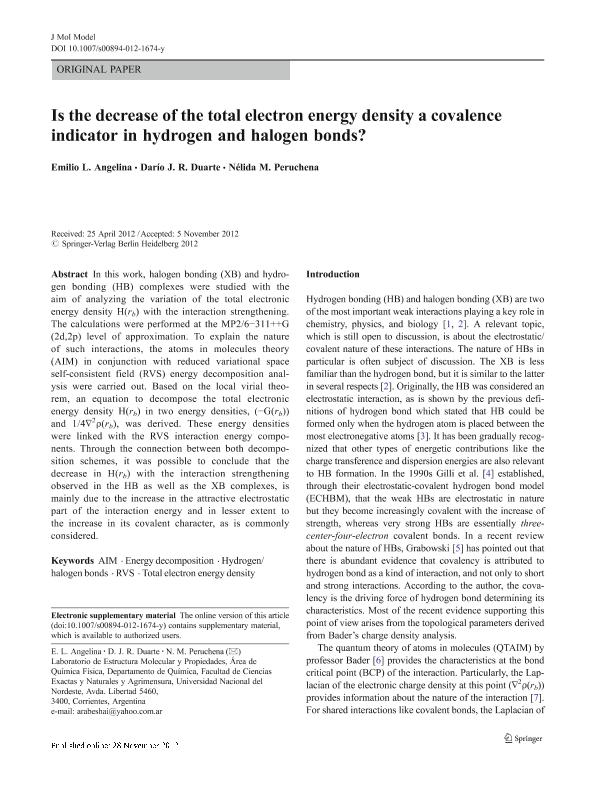Artículo
Is the decrease of the total electron energy density a covalence indicator in hydrogen and halogen bonds?
Fecha de publicación:
05/2013
Editorial:
Springer
Revista:
Journal of Molecular Modeling
ISSN:
1610-2940
Idioma:
Inglés
Tipo de recurso:
Artículo publicado
Clasificación temática:
Resumen
In this work, halogen bonding (XB) and hydrogen bonding (HB) complexes were studied with the aim of analyzing the variation of the total electronic energy density H(rb) with the interaction strengthening. The calculations were performed at the MP2/6-311++G(2d,2p) level of approximation. To explain the nature of such interactions, the atoms in molecules theory (AIM) in conjunction with reduced variational space self-consistent field (RVS) energy decomposition analysis were carried out. Based on the local virial theorem, an equation to decompose the total electronic energy density H(rb) in two energy densities, (-G(rb)) and 1/4Lap rho(rb), was derived. These energy densities were linked with the RVS interaction energy components. Through the connection between both decomposition schemes, it was possible to conclude that the decrease in H(rb) with the interaction strengthening observed in the HB as well as the XB complexes, is mainly due to the increase in the attractive electrostatic part of the interaction energy and in lesser extent to the increase in its covalent character, as is commonly considered.
Archivos asociados
Licencia
Identificadores
Colecciones
Articulos(CCT - NORDESTE)
Articulos de CTRO.CIENTIFICO TECNOL.CONICET - NORDESTE
Articulos de CTRO.CIENTIFICO TECNOL.CONICET - NORDESTE
Articulos(IMIBIO-SL)
Articulos de INST. MULTIDICIPLINARIO DE INV. BIO. DE SAN LUIS
Articulos de INST. MULTIDICIPLINARIO DE INV. BIO. DE SAN LUIS
Citación
Angelina, Emilio Luis; Duarte, Darío Jorge Roberto; Peruchena, Nelida Maria; Is the decrease of the total electron energy density a covalence indicator in hydrogen and halogen bonds?; Springer; Journal of Molecular Modeling; 19; 5; 5-2013; 2097-2106
Compartir
Altmétricas




